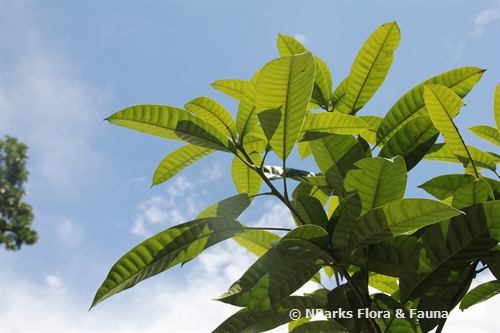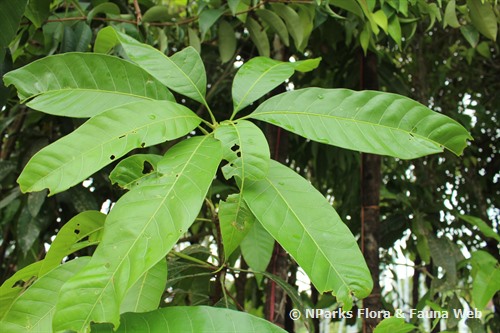
Back
Mangifera foetida Lour.
| Family Name: | Anacardiaceae |
| Common Name: | Horse Mango, Bacang, Bachang, Machang, Machai, Membacang |
Name
Classifications and Characteristics
| Plant Division | Angiosperms (Flowering Seed Plants) |
|---|---|
| Plant Growth Form | Tree (Big (>30m)) |
| Lifespan (in Singapore) | Perennial |
| Mode of Nutrition | Autotrophic |
| Maximum Height | 40 m |
Biogeography
| Native Distribution | Thailand, Vietnam, Sumatra, Peninsular Malaysia, Singapore, Borneo |
|---|---|
| Native Habitat | Terrestrial |
| Preferred Climate Zone | Tropical |
| Local Conservation Status | Native to Singapore (Critically Endangered (CR)) |
Description and Ethnobotany
| Growth Form | It is a tree that can grow up to 40 m tall. |
|---|---|
| Foliage | Its spirally arranged, stalked leaves possess rigid and thickly leathery leaf blades that are narrowly drop-shaped, oval or oblong, dark green, and 12–38 by 6–16 cm. |
| Flowers | Its flowers develop in flowering shoots that are copper-red, and 10–41cm long. Its flowers are pinkish- or deep-red. |
| Fruit | Its 1-seeded fruit is an obliquely egg-shaped fleshy fruit, yellowish or greyish-green, and 7.6–18 by 6–12 cm. The ripe fruit is strongly scented. The single seed is enclosed in a woody capsule in the centre of the fruit flesh. |
| Habitat | It grows in dry lowland and hill forests, up to 1,800 m altitude. It occurs locally in the vicinity of MacRitchie Reservoir, and Singapore Botanic Gardens. |
| Associated Fauna | Its flowers are insect-pollinated. The fruits are eaten by mammals. It is the preferred local food plant for caterpillars of the moths, Chlumetia transversa, Lymantria atemeles, Nacoleia charesalis, Orthaga icarusalis, and Thosea unifascia. |
| Cultivation | It can be propagated by seed. |
| Etymology | Mangi, Indian mango, vernacular name for a Mangifera species; Latin fero, to bear; Latin foetidus, bad-smelling, referring to its strongly scented fruits |
| Ethnobotanical Uses | Edible Plant Parts : Edible Fruits Food (Fruit or Vegetable): Its fruits are used in curries, pickles, rojak, and to make chutneys or sweetmeats. Medicinal: The bark can be made into a lotion for treating ulcer. The leaves are said to alleviate or prevent fever. Its seeds are used against eczema, scabies, and trichophytosis. Timber & Products: The wood is used for light indoor constructions. Cultural / Religious: Heritage Tree : There are currently two individuals of Mangifera foetida listed as Heritage Trees in Singapore. One can be found at MacRitchie Reservoir Park. To find out more about these trees, please visit the Heritage Tree Register. Others: The resinous sap in the stem is used to deepen tattoo scars. |
Landscaping Features
| Landscaping | The plant has attractive flowers. This tree can tolerate the conditions of parks, large gardens, and roadsides, but because of its falling large fruits may pose a danger to pedesterians and motorists, and also can create a mess so less suitable for roadside planting. |
|---|---|
| Desirable Plant Features | Ornamental Flowers, Fragrant (Fruits) |
| Landscape Uses | General, Parks & Gardens |
Fauna, Pollination and Dispersal
| Pollination Method(s) | Biotic (Fauna) |
|---|---|
| Seed or Spore Dispersal | Biotic (Fauna) |
Plant Care and Propagation
| Light Preference | Full Sun |
|---|---|
| Water Preference | Moderate Water |
| Plant Growth Rate | Moderate |
| Rootzone Tolerance | Moist Soils, Well-Drained Soils, Fertile Loamy Soils |
| Propagation Method | Seed |
Foliar
| Foliage Retention | Evergreen |
|---|---|
| Mature Foliage Colour(s) | Green |
| Mature Foliage Texture(s) | Leathery |
| Foliar Type | Simple / Unifoliate |
| Foliar Arrangement Along Stem | Alternate |
| Foliar Attachment to Stem | Petiolate |
| Foliar Shape(s) | Non-Palm Foliage (Lanceolate) |
| Foliar Venation | Pinnate / Net |
| Foliar Margin | Entire |
| Leaf Area Index (LAI) for Green Plot Ratio | 3.0 (Tree - Intermediate Canopy) |
Floral (Angiosperm)
| Flower & Plant Sexuality | Bisexual Flowers |
| Flower Colour(s) | Pink |
|---|---|
| Flower Grouping | Cluster / Inflorescence |
| Flower Symmetry | Radial |
Fruit, Seed and Spore
| Mature Fruit Colour(s) | Green |
|---|---|
| Fruit Classification | Simple Fruit |
| Fruit Type | Fleshy Fruit , Non-Accessory Fruit |
Image Repository
Others
| Master ID | 1719 |
|---|---|
| Species ID | 3012 |
| Flora Disclaimer | The information in this website has been compiled from reliable sources, such as reference works on medicinal plants. It is not a substitute for medical advice or treatment and NParks does not purport to provide any medical advice. Readers should always consult his/her physician before using or consuming a plant for medicinal purposes. |











